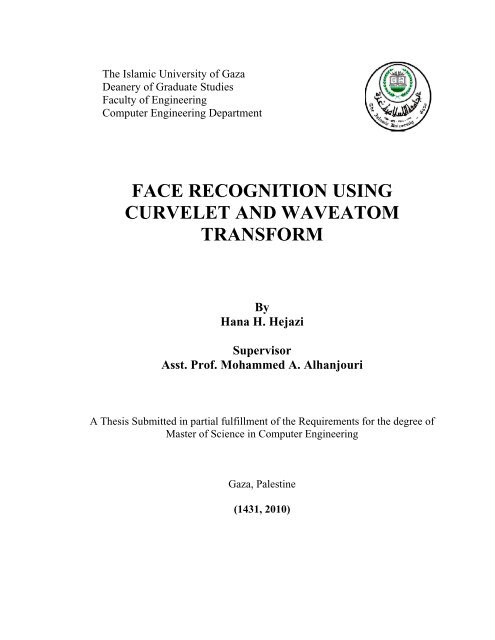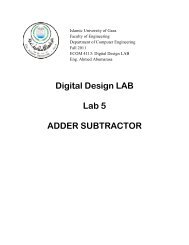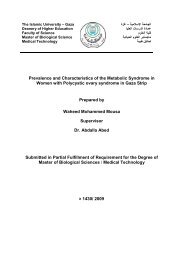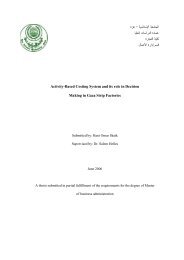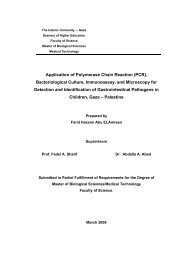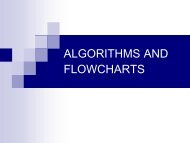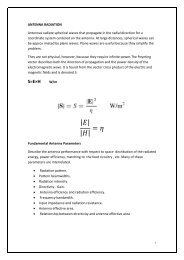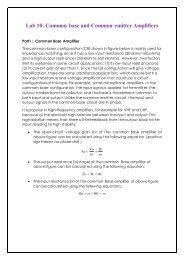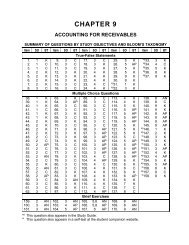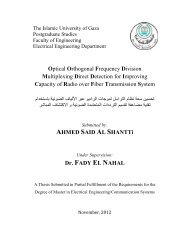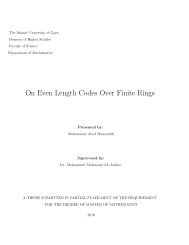face recognition using curvelet and waveatom transform
face recognition using curvelet and waveatom transform
face recognition using curvelet and waveatom transform
Create successful ePaper yourself
Turn your PDF publications into a flip-book with our unique Google optimized e-Paper software.
The Islamic University of Gaza<br />
Deanery of Graduate Studies<br />
Faculty of Engineering<br />
Computer Engineering Department<br />
FACE RECOGNITION USING<br />
CURVELET AND WAVEATOM<br />
TRANSFORM<br />
By<br />
Hana H. Hejazi<br />
Supervisor<br />
Asst. Prof. Mohammed A. Alhanjouri<br />
A Thesis Submitted in partial fulfillment of the Requirements for the degree of<br />
Master of Science in Computer Engineering<br />
Gaza, Palestine<br />
(1431, 2010)
iii
ABSTRACT<br />
The field of digital image processing is continually evolving. Nowadays, there is a<br />
significant increase in the level of interest in image morphology, neural networks, fullcolor<br />
image processing, image data compression <strong>and</strong> image <strong>recognition</strong>. This work deals<br />
with image <strong>recognition</strong> with the application of <strong>face</strong> <strong>recognition</strong>.<br />
Some people think that <strong>face</strong> <strong>recognition</strong> is an easy task for computer system as for<br />
humans, but in reality most of the <strong>face</strong> <strong>recognition</strong> systems can’t achieve a complete<br />
reliable performance because there are many factors affect on the process of <strong>recognition</strong><br />
like: large variations in facial approach, head size <strong>and</strong> orientation, <strong>and</strong> change in<br />
environmental conditions, all these factors makes <strong>face</strong> <strong>recognition</strong> one of the fundamental<br />
problems in pattern analysis, other factors that impact the performance are the accuracy<br />
of <strong>face</strong> location stage <strong>and</strong> the number of actual <strong>face</strong> <strong>recognition</strong> techniques used in each<br />
system. So <strong>face</strong> <strong>recognition</strong> from still <strong>and</strong> video images is emerging as an active research<br />
area with numerous commercial <strong>and</strong> law enforcement application.<br />
This research identifies two techniques for <strong>face</strong> features extraction based on two<br />
different multiresolution analysis tools; the first called Curvelet <strong>transform</strong> while the<br />
second is <strong>waveatom</strong> <strong>transform</strong>. The resultant features are inputted to train via two famous<br />
classifiers; one of them is the artificial neural network (ANN) <strong>and</strong> the other is hidden<br />
Markov model (HMM).<br />
Experiments are carried out on two well-known datasets; AT&T dataset consists of<br />
400 images corresponding to 40 people, <strong>and</strong> Essex Grimace dataset consists of 360<br />
images corresponding to 18 people. Experimental results show the strength of both<br />
<strong>curvelet</strong>s <strong>and</strong> <strong>waveatom</strong> features. On one h<strong>and</strong>, <strong>waveatom</strong> features obtained the highest<br />
accuracy rate of 99% <strong>and</strong> 100% with HMM classifier, <strong>and</strong> 98% <strong>and</strong> 100% with ANN<br />
classifier, for AT&T <strong>and</strong> Essex Grimace datasets, respectively. On the other h<strong>and</strong>, two<br />
levels Curvelet features achieved accuracy rate of 98% <strong>and</strong> 100% with HMM classifier,<br />
<strong>and</strong> 97% <strong>and</strong> 100% with ANN classifier, for AT&T <strong>and</strong> Essex Grimace datasets,<br />
respectively.<br />
A comparative study for <strong>waveatom</strong> with wavelet-based, <strong>curvelet</strong>-based, <strong>and</strong><br />
traditional Principal Component Analysis (PCA) techniques is also presented. The<br />
proposed techniques supersede all of them. And shows the robustness of feature<br />
extraction methods used against included <strong>and</strong> occluded effects. Also, indicates the<br />
potential of HMM over ANN, as they are classifiers.<br />
iv
Acknowledgment<br />
My thanks must first <strong>and</strong> foremost go to ALLAH who gave me all things to produce<br />
this project.<br />
I have the pleasure to have Assistant Professor Mohammed Al Hanjouri as my thesis<br />
supervisor. He introduced me to the field of Image Processing with multiresolution<br />
<strong>transform</strong>s, gave me every effort, <strong>and</strong> guided me patiently throughout this thesis work. I<br />
am highly indebted <strong>and</strong> express my deep sense of gratitude to him for his invaluable<br />
guidance, constant inspiration to present this work.<br />
Many thank to any person who has in one way or another contribution to this work. I<br />
want to express most sincerely appreciation to Professor Ibrahim Abu Haiba, from IUG<br />
computer engineering stuff <strong>and</strong> Asst. Prof. Hatem Elaydi, from IUG electrical<br />
engineering stuff, for their suggestion.<br />
Very big thanks to my university which was my second home since three years <strong>and</strong> it<br />
will still have this value forever.<br />
Finally, I owe my largest debt to my family. I am highly indebted to my parents,<br />
brothers, husb<strong>and</strong>, <strong>and</strong> my loving kids for their love, affection, constant encouragement,<br />
<strong>and</strong> invaluable support throughout this difficult period. I also want to thanks my husb<strong>and</strong><br />
Dr. Hazem who motivated me to the initiate research work. I dedicate this work to all of<br />
them.<br />
v
Table of Contents<br />
List of Figures<br />
List of Abbreviations<br />
vii<br />
viii<br />
CHAPTER 1: INTRODUCTION 1<br />
1.1 The Problem Statement 2<br />
1.2 Literature Review. 3<br />
1.3 Objective <strong>and</strong> outlines of the Thesis 5<br />
CHAPTER 2: FEATURE EXTRACTION TECHNIQUES 7<br />
2.1 Digital Curvelet Transform 7<br />
2.2 Waveatom Transform 12<br />
2.2.1 Waveatom Transform Properties 13<br />
2.2.2 Waveatom Theory 16<br />
CHAPTER 3: HIDDEN MARKOV MODEL 18<br />
3.1 Hidden Markov Model Principles 18<br />
3.2 Parameter Estimation 20<br />
3.3 HMM Applications 22<br />
CHAPTER 4: SYSTEM DESIGN 23<br />
4.1 Preprocessing Stage 23<br />
4.2 Feature Extraction Stage 23<br />
4.2.1Curvelet based Feature Extraction 24<br />
4.2.2 Waveatom based Feature Extraction 24<br />
4.3 The Classification 27<br />
4.3.1 Artificial Neural Network 28<br />
4.3.2 HMM for Face Recognition 29<br />
4.4 Summary 32<br />
CHAPTER 5: SIMULATION RESULTS 34<br />
5.1 Data Collection 34<br />
5.2 Neural Network for Face Recognition 36<br />
5.3 Hidden Markov Model 39<br />
5.4 Comparative Study 43<br />
5.5 Time Requirements 45<br />
5.6 Enclosed Model Selection Criteria 49<br />
CHAPTER 6: CONCLUSION 53<br />
Bibliography 55<br />
vi
List of Figures<br />
Figure 2.1: Curvelet Frequency Tiling 8<br />
Figure 2.2: Edge Representations 9<br />
Figure 2.3: Curvelet Alignments 10<br />
Figure 2.4: Discrete Localizing Window 12<br />
Figure 2.5: Waveatom Transform in Spatial Space <strong>and</strong> in Frequency 15<br />
Figure 2.6: Boundary of Wedge 15<br />
Figure 2.7: Waveatom at Increasing Finer Scale 15<br />
Figure 3.1: A Simple HMM 19<br />
Figure 4.1: Curvelet Coefficients (Approximated <strong>and</strong> Details) 25<br />
Figure 4.2: Sample Images of Curvelet Transform 25<br />
Figure 4.3: Coefficients of Waveatom Transform at Different Scales 26<br />
Figure 4.4: Marginal Distributions 27<br />
Figure 4.5: Artificial Neurons 28<br />
Figure 4.6: Back-propagation Neural Network 29<br />
Figure 4.7: HMM observation vector 31<br />
Figure 5.1: Sample Images from ORL database 34<br />
Figure 5.2: Sample Images from Essex Grimace Database 35<br />
Figure 5.3: Out-class Image Samples 35<br />
Figure 5.4: Results obtained from Optimizing ANN for 2-Level Curvelet<br />
Transform 38<br />
Figure 5.5: Results obtained from Optimizing ANN for Waveatom Transform 40<br />
Figure 5.6: The Classification Success Rate Obtained when <strong>using</strong> Waveatom<br />
Features for Varying Gaussian Densities per State <strong>and</strong> Several<br />
Vector Lengths 42<br />
Figure 5.7:<br />
The Classification Success Rate Obtained when <strong>using</strong> 2 Levels<br />
Curvelet Features for Varying Gaussian Densities per State <strong>and</strong><br />
Several Vector Lengths 43<br />
Figure 5.8: Comparative Studies for ANN 4.5<br />
Figure 5.9: Comparative Studies for HMM 45<br />
Figure 5.10: Feature Extraction’s Time Application 46<br />
Figure 5.11: Time Application in Training ANN 47<br />
Figure 5.12: Time Application in Training HMM 47<br />
Figure 5.13: Time Application in Testing ANN 48<br />
Figure 5.14: Time Application in Testing HMM 49<br />
Figure 5.15:<br />
Figure 5.16:<br />
Figure 5.17:<br />
Comparison of HMM identification accuracy (%)<strong>using</strong> both normal<br />
<strong>and</strong> enclosed datasets 50<br />
Comparison of inclusion identification accuracy (%) <strong>using</strong> HMM<br />
<strong>and</strong> EMC-HMM 51<br />
Comparison of occlusion identification accuracy (%) <strong>using</strong> HMM<br />
<strong>and</strong> EMC-HMM 52<br />
vii
List of Abbreviations<br />
AAM<br />
ANN<br />
CS<br />
CWT<br />
DCT<br />
DFT<br />
DWT<br />
EFM<br />
EM<br />
EMC<br />
FFT<br />
GFC<br />
GM<br />
GWT<br />
HMM<br />
ICA<br />
IGF<br />
KNN<br />
LDC<br />
LoG<br />
LS-SVM<br />
MAP<br />
ML<br />
PCA<br />
PDF<br />
PIN<br />
RBF<br />
SVM<br />
USFFT<br />
WFT<br />
Active Appearance Model.<br />
Artificial Neural Network.<br />
Compressive Sampling or Compressed Sensing.<br />
Continuous Wavelet Transform.<br />
Digital Cosine Transform.<br />
Discrete Fourier Transform.<br />
Discrete Wavelet Transform.<br />
Enhanced Fisher linear discriminant Model.<br />
Expectation-Maximization algorithm.<br />
Enclosed Model Selection Criterion.<br />
Fast Fourier Transform.<br />
Gabor–Fisher Classifier.<br />
The Gaussian mixture modeling.<br />
Gabor Wavelet Transform.<br />
Hidden Markov Model.<br />
Independent Component Analysis.<br />
Independent Gabor features.<br />
k-Nearest Neighbor classifier.<br />
Local Discriminant Coordinates.<br />
Laplacian-of-Gaussian.<br />
Least Square Support Vector Machine.<br />
Maximum a Posteriori logistic model.<br />
Maximum Likelihood.<br />
Principal Component Analysis.<br />
Probability Density Functions.<br />
Personal Identification Number.<br />
Radial Basis Function.<br />
Support Vector Machines.<br />
Unequally Spaced Fast Fourier Transform.<br />
Windowed Fourier Transform.<br />
viii
CHAPTER 1<br />
INTRODUCTION<br />
There are many ways that humans can identify each other, <strong>and</strong> so is for machines.<br />
There are many different identification technologies available, many of which have been<br />
in commercial use for years. The most common verification <strong>and</strong> identification methods<br />
nowadays are Password/PIN (Known as Personal Identification Number) systems. The<br />
problem with that or other similar techniques is that they are not unique <strong>and</strong> is possible<br />
for someone to forget, loose or even have it stolen. In order to overcome these problems<br />
they have developed considerable interest in “biometrics” identification systems, which<br />
use pattern <strong>recognition</strong> techniques to identify people <strong>using</strong> their characteristics. Some of<br />
these methods are fingerprints <strong>and</strong> <strong>face</strong> <strong>recognition</strong>.<br />
A <strong>face</strong> <strong>recognition</strong> system can be used in buildings or specific area security, a <strong>face</strong><br />
recognizer could be used at the frontal entrance for automatic access control, <strong>and</strong> they<br />
could be used to enhance the security of user authentication in ATMs by recognizing<br />
<strong>face</strong>s as well as requiring passwords. Also, these systems can be used in the human or<br />
computer inter<strong>face</strong> arena workstations with cameras would be able to recognize users,<br />
perhaps automatically loading the user environment when he/she sits in the front of the<br />
machine.<br />
A <strong>face</strong> <strong>recognition</strong> system must operate under a variety of conditions, such as varying<br />
illuminations <strong>and</strong> facial expressions; it must be able to h<strong>and</strong>le non-frontal facial images<br />
of both males <strong>and</strong> females of different ages <strong>and</strong> races.<br />
Before <strong>face</strong> <strong>recognition</strong> is performed, <strong>face</strong> detection must take place, so the system<br />
should determine whether or not there is a <strong>face</strong> in a given image, once complete this<br />
process, <strong>face</strong> region should be isolated from the scene for the <strong>face</strong> <strong>recognition</strong>. The <strong>face</strong><br />
detection <strong>and</strong> <strong>face</strong> extraction are often performed simultaneously. Finally, the<br />
classification of the <strong>face</strong> will take place.<br />
Face <strong>recognition</strong> can be done in both a still images <strong>and</strong> video images. Different<br />
approaches of <strong>face</strong> <strong>recognition</strong> for still images can be categorized into two main groups<br />
such as Geometrical approach <strong>and</strong> Pictorial approach.<br />
1
In recent years, multiresolution analysis tools, especially wavelets, had been found<br />
useful for analyzing the content of images; this leads to use these tools in areas like image<br />
processing, pattern <strong>recognition</strong> <strong>and</strong> computer vision. Following wavelets, other<br />
multiresolution tools were developed like contourlets, ridgelets etc. Curvelet <strong>transform</strong> is<br />
a recent addition to this list of multiscale <strong>transform</strong>s while the most modern one is called<br />
Waveatom Transform. Waveatom <strong>transform</strong> used in image processing in the field of<br />
image denoising, <strong>and</strong> the results obtained are the best one when compared to the state of<br />
art [1].<br />
The whole system of <strong>face</strong> <strong>recognition</strong> consist of three main phases, these are:<br />
preprocessing, feature extraction, <strong>and</strong> the classification phases.<br />
1.1 The Problem Statement<br />
The goal of this work is to find the best feature extraction, which performs the<br />
smallest feature vector length <strong>and</strong> gives the highest performance. The features set is<br />
obtained <strong>using</strong> Curvelet <strong>transform</strong> <strong>and</strong> Waveatom <strong>transform</strong>. Artificial Neural Network<br />
(ANN) <strong>and</strong> Hidden Markov Model (HMM) are trained <strong>using</strong> these features. AT&T as an<br />
example of still images, <strong>and</strong> Essex Grimace as video images are used for training <strong>and</strong><br />
testing. The aim is to answer the following questions:<br />
1. Can Curvelet <strong>transform</strong> st<strong>and</strong> alone as feature extraction or not<br />
2. How long feature vector length obtained <strong>using</strong> Curvelet <strong>transform</strong><br />
3. Can Waveatom <strong>transform</strong> used in <strong>face</strong> <strong>recognition</strong><br />
4. How long feature vector length obtained <strong>using</strong> Waveatom <strong>transform</strong><br />
5. Which is the most suitable method to extract feature from a <strong>face</strong> image; Curvelet<br />
or Waveatom<br />
6. Does ANN give good accuracy with feature vectors obtained <strong>using</strong> Curvelet <strong>and</strong><br />
Waveatom Transforms<br />
7. Does HMM give good accuracy with feature vectors<br />
8. Which work better as classifier ANN or HMM<br />
2
1.2 Literature Review<br />
The subject of <strong>face</strong> <strong>recognition</strong> is as old as computer vision, both because of its<br />
practical importance <strong>and</strong> the theoretical interest from scientists, in spite of the fact that<br />
other methods of identification (such as fingerprints, or iris scans) can be more accurate.<br />
Face <strong>recognition</strong> always remains a major focus of research because of its noninvasive<br />
nature <strong>and</strong> because people’s primary method of person identification. Since the<br />
start of that field of technology there were two main approaches:<br />
• Geometrical approach.<br />
• Pictorial approach.<br />
The geometrical approach uses the spatial configuration of facial features. That means<br />
that the main geometrical features of the <strong>face</strong> such as the eyes, nose, <strong>and</strong> mouth are first<br />
located <strong>and</strong> then <strong>face</strong>s are classified on the basis of various geometrical distances <strong>and</strong><br />
angles between features. On the other h<strong>and</strong>, the pictorial approach is <strong>using</strong> the templates<br />
of the major facial features <strong>and</strong> entire <strong>face</strong> to perform <strong>recognition</strong> on frontal views of<br />
<strong>face</strong>s.<br />
Perhaps eigen<strong>face</strong>s is the most famous early technique used in <strong>face</strong> <strong>recognition</strong><br />
systems. Any human <strong>face</strong> can be presented by linear combination of eigen<strong>face</strong> images.<br />
Eigen<strong>face</strong>s is asset of eigenvectors derived from the covariance matrix of a high<br />
dimensional vector that represent possible <strong>face</strong>s of humans. Eigen<strong>face</strong>s have advantages<br />
over other techniques available, such as the system’s speed. The eigen<strong>face</strong>s method<br />
presented by Turk <strong>and</strong> Pentl<strong>and</strong> (1991) [2] have found the principal components of a <strong>face</strong><br />
image.<br />
Unfortunately, these eigen<strong>face</strong>s are sensitive to variety in position <strong>and</strong> scale. For the<br />
system to work well, the <strong>face</strong>s need to be seen from a frontal view under similar lighting.<br />
To overcome this problem they suggest <strong>using</strong> a multi-resolution method in which <strong>face</strong>s<br />
are compared to eigen<strong>face</strong>s of varying sizes to compute the best match. Turk <strong>and</strong><br />
Pentl<strong>and</strong>’s paper was very seminal in the field of <strong>face</strong> <strong>recognition</strong> <strong>and</strong> their<br />
method is still quite popular due to its ease of implementation [3].<br />
Researchers have starting <strong>using</strong> Wavelet coefficients as features for <strong>face</strong> <strong>recognition</strong><br />
in the last years [4, 5, 6, 7, 8]. The simplest application of <strong>using</strong> Wavelet in <strong>face</strong><br />
<strong>recognition</strong> can be found in [4]. The <strong>face</strong> image undergoes 2 levels Wavelet <strong>transform</strong>,<br />
3
the approximate Wavelet coefficients are used in HMM classifier for <strong>recognition</strong>. In [5]<br />
solved the complexity of PCA training time by <strong>using</strong> Wavelet packet decomposition, <strong>and</strong><br />
then used approximated <strong>and</strong> details coefficients to calculate PCA. Researchers in [6] the<br />
<strong>face</strong> image was inputted into 2 levels Discrete Wavelet Transform (DWT) system. The<br />
approximated coefficients projected <strong>using</strong> PCA into eigen<strong>face</strong> space; Support Vector<br />
Machines (SVM) classifier trained <strong>using</strong> these PCA for <strong>recognition</strong>. In [7] Wavelet<br />
frequency subb<strong>and</strong>s were searched to found that is insensitive to expression differences<br />
<strong>and</strong> illumination variants ones on <strong>face</strong>s. The horizontal Wavelet components were found<br />
to be a very good feature in <strong>face</strong> <strong>recognition</strong> <strong>and</strong> yielding the highest performance rates.<br />
Researchers in [8] tried to measure the discriminability of Wavelet package<br />
decomposition with depth 2. They modified a Local Discriminant Coordinates (LDC) by<br />
<strong>using</strong> dilation invariant entropy <strong>and</strong> Maximum Postiriori (MAP) logistic model.<br />
Beyond Wavelet, Gabor <strong>transform</strong> were used to extract features [9, 10, 11, 12, 13,<br />
14]. The <strong>face</strong> image decomposed <strong>using</strong> Gabor <strong>transform</strong> in [9, 10, 11]. In [9] the<br />
dimensionality of Gabor feature vectors was reduced <strong>using</strong> Enhanced Fisher linear<br />
discriminant model (EFM). Nearest neighbor classifier were used for <strong>recognition</strong>. Where<br />
in [10] the dimensionalities of Gabor feature vectors was reduced <strong>using</strong> PCA followed by<br />
ICA. Researchers in [11] applied AdaBoosted algorithm to Gabor features <strong>and</strong> solved the<br />
imbalance between the amount of the positive samples <strong>and</strong> that of negative samples by<br />
re-sampling scheme. In [12] facial feature points were localized by Active Appearance<br />
Model (AAM) <strong>and</strong> refined the localization by Gabor jet similarity, next Gabor feature<br />
vectors extracted at all facial points. In [13] researchers not only applied Gabor <strong>transform</strong><br />
but also Discrete Cosine Transform (DCT) to <strong>face</strong> images. A Radial Basis Function<br />
(RBF) based neural network was trained <strong>using</strong> Gabor coefficients <strong>and</strong> DCT coefficients.<br />
As next step to improve the processing speed they enhanced the edge <strong>and</strong> used nonuniform<br />
down sampling to reduce the dimensionality of Gabor coefficients. In [14] multiscale<br />
Harris-Laplace detector was used to evaluate the interest points. Gabor <strong>transform</strong><br />
was used to extract feature vectors at interest points.<br />
Curvelet <strong>transform</strong> becomes a very popular multi-resolution <strong>transform</strong> after<br />
implementing its second generation. In <strong>face</strong> <strong>recognition</strong>, Curvelet <strong>transform</strong> seems to be<br />
promising [15, 16, 17, 18, 19, 20, 21]. The beginning was in [15]. The <strong>face</strong> images were<br />
4
quantized from 256 to 16 <strong>and</strong> 4 gray scale resolutions, the quantized images were<br />
decomposed <strong>using</strong> Curvelet <strong>transform</strong>. Three SVMs were trained <strong>using</strong> Curvelet<br />
coefficients <strong>and</strong> the decision was made by simple majority voting. In [16] the <strong>face</strong> image<br />
undergoes Curvelet <strong>transform</strong>. PCA was performed on the approximated coefficients. K-<br />
Nearest Neighbor classifier was employed to perform the classification task. In [17] as<br />
preprocessing step researchers converted <strong>face</strong> images from 8 bit into 4 bit <strong>and</strong> 2 bit<br />
representations. Curvelet <strong>transform</strong> was performed to extract feature vectors from these<br />
representations, <strong>and</strong> then the approximated components were used to train different<br />
SVMs. Researchers in [18] addressed the problem of identifying <strong>face</strong>s when the training<br />
<strong>face</strong> database contains one <strong>face</strong> image of each person. The Curvelet approximated<br />
coefficients was framed as a minimization problem. The original image <strong>and</strong> the<br />
reconstructed images of the non-linear approximations were used to generate the training<br />
set. A comparative study amongst Wavelet <strong>and</strong> Curvelet was found in [19]. In [20] the<br />
Curvelet sub-b<strong>and</strong>s were divided into small sub-blocks. Means, variance <strong>and</strong> entropy<br />
were calculated from these sub-blocks as statistical measures. Feature vector was<br />
constructed by concatenated each block measure. Local discriminant analyses (LDA) was<br />
carried out on feature vectors <strong>and</strong> the city-block distance was used for classification.<br />
Researcher in [21] decomposed a <strong>face</strong> image <strong>using</strong> Curvelet <strong>transform</strong> at scale 4. Next<br />
Least Square Support Vector Machine (LS-SVM) was trained <strong>using</strong> Curvelet features.<br />
The results in [17, 18, 19, 20, 21] have showed Curvelet based schemes were better<br />
than wavelet based <strong>recognition</strong> schemes. The results also showed improvement over the<br />
previous approach [15].<br />
1.3 Objective <strong>and</strong> outlines of the Thesis<br />
This thesis introduces new proposed method to extract effective features for <strong>face</strong><br />
<strong>recognition</strong>, <strong>and</strong> it implements many feature extraction techniques to feed several types<br />
of classifiers, these procedures will be produced many combined systems for <strong>face</strong><br />
<strong>recognition</strong>; therefore, the comparative study is necessary to determine the best one.<br />
The present work was organized as following:<br />
Chapter 2 introduces the proposed Feature Extraction methods based on Curvelet <strong>and</strong><br />
Waveatom representation of <strong>face</strong> images. Curvelet theory was presented. Properties of<br />
Waveatom as a multiresolution <strong>transform</strong> were discussed beside its theory.<br />
5
Chapter 3 overviews the Classification technique used. Hidden Markov model<br />
principles were introduced. This chapter gives short summary for the algorithms which<br />
HMM depends on such as Expectation Maximization algorithm <strong>and</strong> Vetribi algorithm.<br />
Chapter 4 talks about the proposed system <strong>and</strong> its architecture. It explains the how the<br />
feature is obtained <strong>and</strong> used to train both of ANN <strong>and</strong> HMM. The topology of ANN <strong>and</strong><br />
HMM was discussed.<br />
Performance of this method is examined on two different st<strong>and</strong>ard <strong>face</strong> databases<br />
with different characteristics. Simulation results <strong>and</strong> their comparisons to well-known<br />
<strong>face</strong> <strong>recognition</strong> methods are presented in chapter 5.<br />
In chapter 6, concluding remarks are stated. Future works, which may follow this<br />
study, are also presented.<br />
6
used instead of concentric circles <strong>and</strong> rotations see Figure 2.1 (b).The frequency plain is<br />
partitioned into radial (circles <strong>and</strong> squares) <strong>and</strong> angular ( rotations <strong>and</strong> shears) divisions.<br />
Different scales are obtained by radial division; the smallest scale defines the finest<br />
resolution while the largest scale defines the coarsest resolution. Angular division divides<br />
each scale into different orientation; the maximum number of orientations was found at<br />
the finest resolution <strong>and</strong> the lesser number of orientations was found at coarsest<br />
resolution.<br />
Curvelets are designed to represent edges <strong>and</strong> other singularities along curves much<br />
more efficiently than the traditional Wavelet <strong>transform</strong> which good at representing point<br />
singularities. Figure 2.2 shows edge representation by both Wavelets <strong>and</strong> Curvelet<br />
Transforms. It can be noticed, it would take many Wavelet coefficients to accurately<br />
represent such a curve while Curvelet needs small number of coefficients; wavelet needs<br />
three, six, <strong>and</strong> twelve coefficients, while Curvelet needs one, two, <strong>and</strong> four coefficients,<br />
in the largest, middle, <strong>and</strong> smallest scale respectively.<br />
To explain how the Curvelet basis elements align with edges in an image <strong>and</strong> how<br />
this alignment affects the coefficients of the corresponding <strong>transform</strong>. Figure 2.2<br />
pictorially depicts the alignment. The first box shows the original image. In the second<br />
box, the b<strong>and</strong>-passed image (image at a certain resolution) is shown. Finally in the third<br />
box the alignment of the Curvelet basis elements with a small section of the edge is<br />
shown <strong>and</strong> will now be briefly explained.<br />
Figure 2.1: Curvelet Frequency Tiling (a): Continuous Domain.<br />
(b): Discrete Domain<br />
8
2. For each scale j <strong>and</strong> angle l, the product Ữ j,l [n 1 ,n 2 ] ĝ[n 1 ,n 2 ] is formed, where Ữ j,l<br />
[n 1 ,n 2 ] is the discrete localizing window (Figure 2.4 (a)).<br />
3. This product is wrapped around the origin to obtain ğ j,l [n 1 ,n 2 ] = W(Ữ j,l ĝ) [n 1 ,n 2 ];<br />
where the range for n 1 ,n 2 is now 0≤ n 1
2.2.1 Waveatom Transform Properties<br />
To be a Multiresolution image <strong>transform</strong>s, five properties should be satisfied:<br />
1. Multiresolution: The <strong>transform</strong> should allow images to be successively<br />
approximated, from coarse to fine resolutions.<br />
2. Localization: The basis elements of the <strong>transform</strong>s should be localized in both the<br />
spatial <strong>and</strong> the frequency domains.<br />
3. Critical sampling: For some applications (e.g., compression), the <strong>transform</strong>s<br />
should form a basis, or a frame with small redundancy.<br />
4. Directionality: The <strong>transform</strong> should contain basis elements oriented at a variety<br />
of direction.<br />
5. Anisotropy: When a physical property changes with direction, that property is<br />
said anisotropy. For image <strong>transform</strong>s, anisotropicity means that the basis<br />
elements of the <strong>transform</strong>s should not be circular (similar in all directions) but<br />
may be elliptical (more along the major axis <strong>and</strong> less along the minor axis); the<br />
circular basis repeats itself many times <strong>and</strong> this does not the case of elliptical one.<br />
The core of the Waveatom <strong>transform</strong> [24] is displayed in Figure 2.5. On the right of<br />
Figure 2.5, the frequency plane is divided into wedges. The wedge is formed by<br />
partitioning the frequency plane into radial <strong>and</strong> angular divisions. The radial divisions<br />
(concentric circles) are for b<strong>and</strong>-passing the image at different resolution/scales. The<br />
angular divisions divide each b<strong>and</strong>-passed image into different angles. To consider each<br />
wedge, the b<strong>and</strong>-passed image should be analyzed at scale j <strong>and</strong> angle θ.<br />
The second property of the wish-list requires the <strong>transform</strong> to be localized both in the<br />
frequency <strong>and</strong> the spatial domain. However, a signal that is perfectly localized in one<br />
domain is spread out in the other. So, one can only expect the <strong>transform</strong> to be<br />
approximately localized in both domains. The image on the right of Figure 2.5 shows<br />
how the frequency plane is divided into wedges. If a wedge has an abrupt boundary in the<br />
frequency domain, it will be spread in the spatial domain. To avoid that, the boundary of<br />
the wedge is tapered as shown in Figure 2.6. The dotted line shows an abrupt wedge<br />
boundary, the continuous lines show the actual wedge boundary which is tapered off.<br />
This smooth tapering allows for localization in both the frequency <strong>and</strong> spatial domains.<br />
13
From Figure 2.5, once the scale <strong>and</strong> the angle are defined, the wedge is identified.<br />
The wedge is inverted to the spatial domain (left side of Figure 2.5) by Inverse Fourier<br />
<strong>transform</strong>. The inverse Fourier <strong>transform</strong> of the wedge are the Waveatoms corresponding<br />
to the wedge at particular scale <strong>and</strong> angle. The Waveatoms are periodic <strong>and</strong> repeated<br />
infinitely. In Figure 2.5 they are shown as ellipses, the centers of the ellipses are shown<br />
as dots.<br />
Figure 2.8 shows a wedge (in the frequency domain) on the right, <strong>and</strong> a Waveatom<br />
(in spatial domain) corresponding to the wedge on the left. As we can see, the Waveatom<br />
is not exactly an ellipse as depicted in Figure 2.5. It is elongated in one direction <strong>and</strong><br />
wave-like in the other but its effective support is elliptical as shown in the left of Figure<br />
2.5 <strong>and</strong> 2.7. The relationship between the length of major <strong>and</strong> minor axes of the ellipse<br />
follows a parabolic scaling law, i.e. major axis length ≈ (minor axis length) 2 . However,<br />
the values of the Waveatom coefficients are determined by how much the Waveatom <strong>and</strong><br />
the actual image are aligned.<br />
What sets them apart from other <strong>transform</strong> architectures like Wavelets or Curvelets;<br />
Waveatoms have a sharp frequency localization that cannot be achieved <strong>using</strong> wavelet<br />
packets <strong>and</strong> offer a significantly sparser expansion for oscillatory functions than wavelets<br />
<strong>and</strong> Curvelets. Waveatoms capture the coherence of patterns across <strong>and</strong> along oscillations<br />
whereas Curvelets capture coherence along oscillations only. Waveatoms precisely<br />
interpolate between Gaboratoms <strong>and</strong> wavelets means that the period of oscillations of<br />
each wave packet is related to the size of essential support by parabolic scaling i.e.<br />
wavelength ~ (diameter) 2 , which is known as the scaling law [25].<br />
14
Figure 2.5: Waveatom Transform in Spatial Space (left) <strong>and</strong> in Frequency (right)<br />
Figure 2.6: Boundary of Wedge<br />
Figure 2.7: Waveatom at Increasing Finer Scale. Waveatom in Spatial Domain (left) <strong>and</strong> it’s<br />
Frequency Domain (right)<br />
15
probabilities (observation <strong>and</strong> transitions) were contained on that path, the best timealignment<br />
of the frames is obtained, <strong>and</strong> this is so-called Viterbi algorithm.<br />
In <strong>recognition</strong> stage, preferably, the decision depend on the maximum score path in<br />
the model, which is obtained by the viterbi algorithm. At each node in the viterbi trellis,<br />
only the best path leading to this node is kept <strong>and</strong> the rest are dropped. This continues<br />
until all frames are done. Thus at each node to select one path <strong>and</strong> one score is recorded.<br />
3.3 HMM Applications<br />
Neither the theory of HMM nor its application in the field of <strong>recognition</strong> is new.<br />
Hidden Markov Models have been successfully used for speech <strong>recognition</strong> where data is<br />
essentially one dimensional. Extension to a fully connected two dimensional HMM has<br />
been shown to be computationally very complex.<br />
HMM seems to be a promising method that works well for images with variation in<br />
different lighting, facial expression, <strong>and</strong> orientation. The system being modeled is<br />
assumed to be a Markov process with unknown parameters, <strong>and</strong> the goal is to find hidden<br />
parameters from the observable parameters. Each state in HMM has a probability<br />
distribution over the possible output whereas each state in a regular Markov model is<br />
observable.<br />
22
The feature extraction stage was implemented <strong>using</strong> two modern multiresolution<br />
<strong>transform</strong>; the first is the Curvelet <strong>transform</strong> <strong>and</strong> the second is the Waveatom <strong>transform</strong>.<br />
CurveLab-2.1.2 Matlab package [30] was used to yield Curvelet feature vectors.<br />
Waveatom feature vectors were outperformed <strong>using</strong> WaveAtom-1.1.1 matlab package<br />
[31].<br />
4.2.1 Curvelet based Feature Extraction<br />
In order to extract feature vectors, the images are decomposed into its approximate<br />
<strong>and</strong> detailed components <strong>using</strong> two levels of Curvelet <strong>transform</strong>. These sub-images thus<br />
obtained are called curve<strong>face</strong>s. These curve<strong>face</strong>s greatly reduces the dimensionality of<br />
the original image. Thereafter only the approximate components are selected to perform<br />
further computations, as they account for maximum variance. Thus, a representative <strong>and</strong><br />
efficient feature set is produced. Figure 4.1 shows the Curvelet coefficients of a <strong>face</strong> from<br />
ORL dataset decomposed at scale = 2 <strong>and</strong> angle = 8. The image in the first row is the<br />
original image. The coarse scale (low frequency) is first image in the second row, which<br />
so-called approximate coefficients. The other images are finest scale which so-called<br />
detail coefficients.<br />
The <strong>face</strong> images, belongs to ORL <strong>and</strong> Essex Grimace dataset, are decomposed <strong>using</strong><br />
Curvelet <strong>transform</strong> at scale = 3 <strong>and</strong> angle = 8. Thus 25 components are produced,<br />
including 1 approximate <strong>and</strong> 24 detailed sub-b<strong>and</strong>. The resolution of the approximate<br />
subb<strong>and</strong> is reduced to 42 x 37 <strong>and</strong> 42 x 42 for images of ORL <strong>and</strong> Essex Grimace<br />
respectively. To further reduce the dimensionality, Curvelet <strong>transform</strong>, at scale = 3 <strong>and</strong><br />
angle = 8, was applied once again on these approximate components only. The resolution<br />
of the approximated subb<strong>and</strong> became 13x15 <strong>and</strong> 15x15 for images of ORL <strong>and</strong> Essex<br />
Grimace respectively as shown in Figure 4.2. A total of 195 features of Curvelet subimages<br />
are produced.<br />
4.2.2 Waveatom based Feature Extraction<br />
Waveatom decomposition is used for sparse representation of <strong>face</strong> images since they<br />
belong to a category of images that oscillate smoothly in varying directions. Firstly,<br />
discrete 2D Waveatom decomposition is applied to the original <strong>face</strong> image; to efficiently<br />
capture coherence patterns along <strong>and</strong> across the oscillations. Figure 4.3 shows the<br />
Waveatom coefficients of a <strong>face</strong> from ORL dataset decomposed at different scales. The<br />
24
highest coefficients value is inserted first in the coefficients array within each scale; the<br />
array sorted descending. The upside right block shows the coefficients at scale three,<br />
actually the number of feature vector is 8 x 8 features. The down side left block shows<br />
scale four coefficients, coefficients array length 50 x 50 coefficients. The block in the<br />
downside right shows scale five coefficients which is 120 x 120 coefficients.<br />
Figure 4.1: Curvelet Coefficients (Approximated <strong>and</strong> Details)<br />
Figure 4.2: Sample Images of Curvelet Transform<br />
25
CHAPTER 5<br />
SIMULATION RESULTS<br />
This chapter talks about the Experimental results obtained <strong>and</strong> how it obtained,<br />
discusses it in deep, <strong>and</strong> compares it to show the benefit to use the proposed method.<br />
5.1 Data Collection<br />
Experiments were carried out <strong>using</strong> three datasets from different sources: ORL<br />
(AT&T) database, Essex Grimace database <strong>and</strong> Yale database, both sets are used to<br />
implement different Algorithms to recognize the human <strong>face</strong>.<br />
ORL (AT&T) database [33] contains distinct <strong>face</strong> images sets for 40 persons with<br />
dimension of 92×112, <strong>and</strong> each set consists of 10 different images for the same person.<br />
For some persons, images were taken at different times varying the lighting, facial<br />
expression (open / closed eyes, smiling / not smiling) <strong>and</strong> facial details (glasses / no<br />
glasses). All the images were taken against a dark homogeneous background with the<br />
<strong>face</strong>s in an upright, frontal position (with tolerance for some side movement). Sample<br />
images of this dataset are shown in Figure 5.1.<br />
Figure 5.1: Sample Images from ORL database<br />
Essex Grimace database [34] contains sequence <strong>face</strong> images for 18 persons each one<br />
has 20 images (180×200), all images taken with a fixed camera for male <strong>and</strong> female.<br />
During the sequence, the subject moves his/her head <strong>and</strong> makes grimaces which get more<br />
extreme towards the end of the sequence. Images are taken against a plain background,<br />
with very little variation in illumination. Sample images of this database are shown in<br />
Figure 5.2. For the purposes of the experiments carried out, the Essex <strong>face</strong>s were<br />
converted to grayscale prior to training.<br />
Experiments were carried out <strong>using</strong> Matlab R2008a on 2 Due CPU, 2.27 GHz laptop<br />
processor, <strong>and</strong> 2 GB RAM.<br />
First of all, the preprocessing is performed on all <strong>face</strong> images <strong>and</strong> for all datasets.<br />
34
Figure 5.2: Sample Images from Essex Grimace Database<br />
First of all, the preprocessing is performed on all <strong>face</strong> images <strong>and</strong> for all datasets. In<br />
order to build a confusion datasets; inclusion data sets were built by add gray level to <strong>face</strong><br />
image in different parts of <strong>face</strong>s while occlusion data sets were built by cropping different<br />
parts of <strong>face</strong>s. Bellow, Figure 5.3 shows samples of out-class image from ORL <strong>and</strong> Yale<br />
datasets. Indeed, for each dataset, each person has two enclosed data classes; the first<br />
class is included data class which contains four included <strong>face</strong> images <strong>and</strong> six normal <strong>face</strong><br />
images, the second class is occluded data class which contains four occluded <strong>face</strong> images<br />
<strong>and</strong> six normal <strong>face</strong> images.<br />
Figure 5.3: Out-class Image Samples<br />
In order to assess the efficiency of the proposed technique described in the previous<br />
chapter, a series of experiments were carried out <strong>using</strong> all databases separately.<br />
Therefore, with AT&T database, six images were used for training <strong>and</strong> four images for<br />
testing during each run. When <strong>using</strong> the Essex 95 database, nine images were used for<br />
training <strong>and</strong> eleven images for testing during each run. One HMM model was trained for<br />
each individual in the database.<br />
35
After feature extraction take place, it’s time to perform the identification task. The<br />
classification is performed by two different techniques; the first is gradient descent backpropagation<br />
neural network with adaptive learning rate, while the second is HMM.<br />
5.2 Neural Network for Face Recognition<br />
Neural networks have been widely used in many pattern <strong>recognition</strong> problems, such<br />
as optical character <strong>recognition</strong>, <strong>and</strong> object <strong>recognition</strong>. Since <strong>face</strong> detection can be<br />
treated as a two class pattern <strong>recognition</strong> problem, various neural network architectures<br />
have been proposed. The advantage of <strong>using</strong> neural networks for <strong>face</strong> detection is the<br />
feasibility of training a system. This feasibility used to capture the complex class<br />
conditional density of <strong>face</strong> patterns. However, one drawback is that the network<br />
architecture has to be extensively tuned (number of layers, number of nodes, learning<br />
rates, etc.) to get exceptional performance.<br />
The aim of initial experiments was to investigate the efficiency of <strong>using</strong> both of two<br />
levels Curvelet <strong>transform</strong> <strong>and</strong> Waveatom <strong>transform</strong> for extract features with gradient<br />
descent backpropagation ANN based <strong>face</strong> <strong>recognition</strong> task.<br />
The gradient descent with momentum training function was used to update weight<br />
<strong>and</strong> bias values. Tan sigmoid transfer function <strong>and</strong> linear transfer function were used in<br />
hidden layers <strong>and</strong> output layer respectively. The number of hidden layer <strong>and</strong> the number<br />
of nodes in each layer are varied to obtain the optimal back-propagation neural network<br />
topology for highest performance with both 2-level Curvelet Transform <strong>and</strong> Waveatom<br />
Transform. As shown in Figures 5.4 <strong>and</strong> 5.5, the number of hidden layer <strong>and</strong> the number<br />
of nodes in each one are important parameter to improve the <strong>recognition</strong> rate (success<br />
rate).<br />
From Figure 5.4 (a) for both ORL <strong>and</strong> Essex Grimace data sets, when the ANN<br />
topology has one hidden layer; starting with 20 nodes in the first hidden layer <strong>and</strong><br />
increased them to be 80 nodes. It can be seen that the curves in Figure 5.4 (a) is a linear<br />
piecewise curves. The success rate obtained was 87% <strong>and</strong> 88% for ORL <strong>and</strong> Essex<br />
Grimace databases respectively <strong>using</strong> 20 nodes in the first hidden layer. With 30 nodes,<br />
the success rate increased to become 89% for ORL database <strong>and</strong> 90% for Essex Grimace<br />
database. With 40 nodes, the success rate increased to become 91% for ORL database<br />
<strong>and</strong> 95% for Essex Grimace database. Once again it increased to be 97% <strong>and</strong> 100% for<br />
36
ORL <strong>and</strong> Essex Grimace databases respectively. The success rate decreased to 93% <strong>and</strong><br />
97% for ORL <strong>and</strong> Essex Grimace databases respectively <strong>using</strong> 60 nodes in the first<br />
hidden layer. With 70 nodes the success rate was 90% for ORL database <strong>and</strong> 96% for<br />
Essex Grimace database. With 80 nodes it decreased to 89% <strong>and</strong> 94% for ORL <strong>and</strong> Essex<br />
Grimace databases.<br />
From Figure 5.4 (b) for both ORL <strong>and</strong> Essex Grimace data sets, when the ANN<br />
topology has two hidden layers; the number of nodes is 50 nodes in the first hidden layer.<br />
The number of nodes will be varied to found the optimum number of nodes for the<br />
second hidden layer. Beginning with 20 nodes in the second hidden layer <strong>and</strong> increased<br />
them to be 80 nodes. It can be seen that the curves in Figure 5.3 (b) is a linear piecewise<br />
curves. The success rate obtained was 85% for ORL <strong>and</strong> Essex Grimace databases. <strong>using</strong><br />
20 nodes in the first hidden layer. With 30 nodes, the success rate increased to become<br />
87% for ORL database <strong>and</strong> 88% for Essex Grimace database. With 40 nodes, the success<br />
rate increased to become 90% for ORL database <strong>and</strong> 92% for Essex Grimace database.<br />
Once again it increased to be 95% <strong>and</strong> 98% for ORL <strong>and</strong> Essex Grimace databases<br />
respectively. The success rate decreased to 92% <strong>and</strong> 95% for ORL <strong>and</strong> Essex Grimace<br />
databases respectively <strong>using</strong> 60 nodes in the first hidden layer. With 70 nodes the success<br />
rate was 90% for ORL database <strong>and</strong> 93% for Essex Grimace database. With 80 nodes it<br />
decreased to 88% <strong>and</strong> 91% for ORL <strong>and</strong> Essex Grimace databases.<br />
The success classification rate increased with increasing nodes till 50 nodes then<br />
decrement again. The best <strong>recognition</strong> rate with 2-level Curvelet Transform achieved<br />
97% at 50 nodes in the first hidden layer.<br />
On Waveatom side, number of nodes <strong>and</strong> numbers of hidden layer were varied to<br />
obtain the best neural network topology. Beginning with one hidden layer contained 10<br />
nodes; the success rate was 90% <strong>and</strong> 98% for AT&T <strong>and</strong> Essex Grimace database.<br />
Piecewise linear incremental success rate function was shown in Figure 5.5 (a) till<br />
reaches 20 nodes in the first hidden layer. With 15 nodes, the success rate increased to<br />
become 94% for ORL database <strong>and</strong> 99% for Essex Grimace database. Once again it<br />
increased with 20 nodes to 98% <strong>and</strong> 100% for ORL <strong>and</strong> Essex Grimace databases<br />
respectively. The success rate decreased to 98% <strong>and</strong> still 100% for ORL <strong>and</strong> Essex<br />
Grimace databases respectively <strong>using</strong> 30 nodes in the first hidden layer. With 40 nodes<br />
37
the success rate was 94% for ORL database <strong>and</strong> 98% for Essex Grimace database. With<br />
50 nodes it decreased to 88% <strong>and</strong> 98% for ORL <strong>and</strong> Essex Grimace databases.<br />
(a)<br />
(b)<br />
Figure 5.4: Results obtained from Optimizing ANN for 2-Level Curvelet Transform, (a):<br />
optimizing 1 st layer, (b): optimizing 2 nd layer<br />
Now the topology would be consisted from 20 nodes in the first hidden layer <strong>and</strong><br />
numbers of nodes in the second layer will be varied starting with 10 nodes till 50 nodes.<br />
As can be seen from Figure 5.5 (b), with 10 nodes the success rate was 87% <strong>and</strong> 96% for<br />
38
AT&T <strong>and</strong> Essex Grimace database respectively. The success rate was 93% for ORL<br />
database <strong>and</strong> 98% for Essex Grimace database with 15 nodes. Once again it increased<br />
with 20 nodes to 91% <strong>and</strong> 100% for ORL <strong>and</strong> Essex Grimace databases respectively. The<br />
success rate decreased to 87% <strong>and</strong> 98% for ORL <strong>and</strong> Essex Grimace databases<br />
respectively <strong>using</strong> 30 nodes in the first hidden layer. With 40 nodes the success rate was<br />
90% for ORL database <strong>and</strong> 97% for Essex Grimace database. With 50 nodes it decreased<br />
to 85% <strong>and</strong> 94% for ORL <strong>and</strong> Essex Grimace databases.<br />
The best <strong>recognition</strong> rate with Waveatom Transform achieved 98% at 20 nodes in the<br />
first layer while the success rate was 93% at 15 nodes in the second layer for ORL<br />
database.<br />
Clearly, the ANN topology should contain one hidden layer with 50 <strong>and</strong> 20 nodes to<br />
get the highest performance by <strong>using</strong> 2-level Curvelet <strong>and</strong> Waveatom Transforms<br />
respectively for ORL dataset. The same results are obtained for Essex Grimace dataset.<br />
The comparison between the two databases that used is not fair for many reasons: each<br />
database has different size, ORL database are gray images while Essex Grimace data are<br />
colored images, <strong>and</strong> ORL data was captured by photographic camera while Essex<br />
Grimace was obtained <strong>using</strong> video camera.<br />
In order to show the robustness of the system, the system was tested <strong>using</strong> <strong>face</strong><br />
images from outside training data sets. The reject rate was 1.5% with Waveatom based<br />
ANN <strong>and</strong> 2.75% with two levels Curvelet based ANN.<br />
5.3 Hidden Markov Model<br />
The next set of experiments was designed to investigate the efficiency of <strong>using</strong> both<br />
of two levels Curvelet <strong>transform</strong> <strong>and</strong> Waveatom <strong>transform</strong> for extract features with HMM<br />
based <strong>face</strong> <strong>recognition</strong> task. The approximated Curvelet coefficients which of size equal<br />
to 15 × 15, were used as feature vector. Scale three Waveatom coefficients which of size<br />
equal to 8 × 8, were used as feature vector. A model which contains five states as<br />
discussed in the previous chapter.<br />
39
(a)<br />
(b)<br />
Figure 5.5: Results obtained from Optimizing ANN for Waveatom Transform, (a):<br />
optimizing 1 st layer, (b): optimizing 2 nd layer<br />
A varied window Waveatom feature vector is used by <strong>using</strong> five states <strong>and</strong><br />
optimizing both of feature vector length <strong>and</strong> the number of Gaussians densities per state.<br />
Figure 5.6 shows the classification success rate for varying Gaussian densities per state<br />
<strong>and</strong> several vector lengths for ORL (AT&T) <strong>and</strong> Essex Grimace databases, respectively.<br />
In the case of <strong>using</strong> HMM with 2 levels Curvelet Transform, one would resize feature<br />
40
vector to be 12 x 12 <strong>and</strong> 24 x 24 for AT&T <strong>and</strong> Essex Grimace respectively; to could<br />
divide the observation vector to different lengths. Figure 5.7 shows the classification<br />
error rate for varying Gaussian densities per state <strong>and</strong> several vector lengths for ORL<br />
(AT&T) <strong>and</strong> Essex Grimace databases, respectively.<br />
The curves in Figure 5.6 <strong>and</strong> Figure 5.7 consist of piecewise continuous lines<br />
increasing inside the interval [1,3[ of Gaussian densities per state for ORL (AT&T) <strong>and</strong><br />
Essex Grimace databases of <strong>face</strong>s, respectively. Whereas it becomes decreasing inside<br />
the interval [3,4[ of Gaussian densities per state for ORL database. In the other side, it<br />
seems constants for Essex Grimace dataset in the last interval. The curves becomes<br />
increasing again in the interval [4,5[ of Gaussian densities per state for both ORL <strong>and</strong><br />
Essex Grimace dataset, respectively. Again, the curves become decreasing inside the<br />
interval [6,8[ of Gaussian densities per state for both datasets.<br />
Empirically, Figure 5.6 yields that the best result for success rate by <strong>using</strong> Waveatom<br />
features were obtained <strong>using</strong> a certain values of several parameters, such as: 5 states in<br />
each HMMs, 6 Gaussian densities per each state, <strong>and</strong> a length of 8 x 2 window size as an<br />
observation vectors. These HMM parameters was produced a classification rate of 99%<br />
<strong>and</strong> 100% for ORL (AT&T) <strong>and</strong> Essex Grimace databases of <strong>face</strong>s, respectively.<br />
In fact, Figure 5.7 summarizes the following: <strong>using</strong> 5 states in HMM, the best result<br />
for success rate when <strong>using</strong> 2 levels Curvelet features was 98% with AT&T <strong>face</strong>s <strong>and</strong><br />
100% with Essex <strong>face</strong>s. These results were obtained with a length of 24 x 3 <strong>and</strong> 12 x 3<br />
window size for feature vectors, for both Essex Grimace <strong>and</strong> AT&T respectively, (<strong>and</strong> 6<br />
Gaussian densities per each state).<br />
In order to show the robustness of the system, the system was tested <strong>using</strong> <strong>face</strong><br />
images from outside training data sets. The reject rate was 1% with Waveatom based<br />
HMM <strong>and</strong> 2% with two levels Curvelet based HMM.<br />
41
(a)<br />
(b)<br />
Figure 5.6: The Classification Success Rate Obtained when <strong>using</strong> Waveatom Features for<br />
Varying Gaussian Densities per State <strong>and</strong> Several Vector Lengths: (a) For Essex Grimace<br />
database of <strong>face</strong>s (b) For ORL (from AT&T) databases of <strong>face</strong>s<br />
42
(a)<br />
(b)<br />
Figure 5.7: The Classification Success Rate Obtained when <strong>using</strong> 2 Levels Curvelet<br />
Features for Varying Gaussian Densities per State <strong>and</strong> Several Vector Lengths: (a) For<br />
Essex Grimace database of <strong>face</strong>s (b) For ORL (from AT&T) databases of <strong>face</strong>s<br />
5.4 Comparative Study<br />
In the previous two sections, different results have been presented. In order to show<br />
the capability of the proposed method one has compared it against the most popular<br />
existing techniques. A 3-level wavelet decomposition <strong>using</strong> ‘Haar’ wavelet was<br />
performed for wavelet based PCA technique. The best highest 50 eigenvectors were<br />
selected for both Curvelet <strong>and</strong> wavelet based PCA.<br />
43
Figure 5.8 summarizes the results of the comparative study. It shows the <strong>recognition</strong><br />
success rate of three different methods, <strong>and</strong> compares the results with the ANN results<br />
obtained in this thesis. These methods are two levels Curvelet Transform <strong>and</strong> Waveatom<br />
Transform. Both of them used as feature extraction techniques. The classification<br />
technique was the gradient descent backpropagation ANN. The results show that the<br />
proposal methods have the highest Recognition Rate. For two levels Curvelet features,<br />
the success rate was 97% <strong>and</strong> 100% for ORL (AT&T) <strong>and</strong> Essex Grimace databases of<br />
<strong>face</strong>s, respectively. In the other side, Waveatom features have the highest success rate.<br />
The success rate was 98% <strong>and</strong> 100% for ORL (AT&T) <strong>and</strong> Essex Grimace databases of<br />
<strong>face</strong>s, respectively. These results was against 93%, 94%, 96% when <strong>using</strong> eigen<strong>face</strong>s<br />
features, Wavelet+PCA features <strong>and</strong> Curvelet+PCA features, respectively, for ORL<br />
(AT&T) database of <strong>face</strong>s. And it was 70%, 98%, 100% when <strong>using</strong> eigen<strong>face</strong>s features,<br />
Wavelet+PCA features <strong>and</strong> Curvelet+PCA features, respectively, for Essex Grimace<br />
database of <strong>face</strong>s.<br />
Figure 5.9 compares the <strong>recognition</strong> rate obtained of three different methods against<br />
the rate obtained when use HMM classifier. Feature extraction obtained by both tow level<br />
Curvelet Transform <strong>and</strong> Waveatom Transform. The classification technique was HMM.<br />
The results show that Waveatom features have the highest <strong>recognition</strong> rate once again.<br />
For two levels Curvelet features, the success rate was 98% <strong>and</strong> 100% for ORL (AT&T)<br />
<strong>and</strong> Essex Grimace databases of <strong>face</strong>s, respectively. In the other side, Waveatom features<br />
have the highest success rate. The success rate was 99% <strong>and</strong> 100% for ORL (AT&T) <strong>and</strong><br />
Essex Grimace databases of <strong>face</strong>s, respectively. These results was against 93%, 95%,<br />
96% when <strong>using</strong> eigen<strong>face</strong>s features, Wavelet+PCA features <strong>and</strong> Curvelet+PCA features,<br />
respectively, for ORL (AT&T) database of <strong>face</strong>s. And it was 75%, 98%, 100% when<br />
<strong>using</strong> eigen<strong>face</strong>s features, Wavelet+PCA features <strong>and</strong> Curvelet+PCA features,<br />
respectively, for Essex Grimace database of <strong>face</strong>s.<br />
Backing to Figure 5.8 <strong>and</strong> 5.9, one note that both of the proposal methods for feature<br />
Extraction supersede the state of art in this era, <strong>and</strong> viewed as promised way for more<br />
studying. Actually either use the HMM classifier or the ANN classifier, Waveatom<br />
features achieve the highest success rate, behind it the features obtained from two levels<br />
Curvelet Transform.<br />
44
Figure 5.8: Comparative Studies for ANN<br />
Figure 5.9: Comparative Studies for HMM<br />
5.5 Time Requirements<br />
In addition to identification accuracy, an important factor in <strong>face</strong> <strong>recognition</strong> system<br />
is time requirements for whole system stages.<br />
For Feature Extraction process, Figure 5.10 shows the time requirements per one <strong>face</strong><br />
image. Wavelet <strong>face</strong> + PCA feature extraction time was 0.2698 seconds <strong>and</strong> 0.177401<br />
seconds for AT&T database <strong>and</strong> Essex Grimace database respectively. This time is<br />
increased when <strong>using</strong> the first generation Curvelet + PCA to become 0.194903 seconds<br />
for AT&T database <strong>and</strong> 0.311185 seconds for Essex Grimace data base, since the high<br />
45
edundancy which suffers from. The time application was 0.1887 seconds for AT&T data<br />
base <strong>and</strong> 0.2388 seconds for Essex Grimace with two levels second generation Curvelet<br />
<strong>transform</strong>. Waveatom feature Extraction time was 0.12623 seconds for AT&T database<br />
<strong>and</strong> 0.168477 seconds for Essex Grimace data base.<br />
In particular, two levels Curvelet seems to be faster than all of Wavelet + PCA <strong>and</strong><br />
Curvelet + PCA. Actually, Waveatom <strong>transform</strong> is the fastest one of all multiresolution<br />
<strong>transform</strong>s.<br />
For Classification task, two times should be measured; the first is training phase time<br />
<strong>and</strong> the later is testing phase time. In training both ANN <strong>and</strong> HMM classifier, the time<br />
application is measured <strong>and</strong> summarized in Figure 5.11 <strong>and</strong> 5.12, respectively.<br />
As can be seen from Figure 5.11, Wavelet <strong>face</strong> + PCA ANN training time was 221<br />
minutes <strong>and</strong> 71 minutes for AT&T database <strong>and</strong> Essex Grimace database respectively.<br />
The training time is increased when <strong>using</strong> the first generation Curvelet + PCA to become<br />
194 minutes for AT&T database <strong>and</strong> 67 minutes for Essex Grimace data base. The time<br />
application was 123 minutes for AT&T data base <strong>and</strong> 39 minutes for Essex Grimace with<br />
two levels second generation Curvelet <strong>transform</strong>. Waveatom feature Extraction time was<br />
55 minutes for AT&T database <strong>and</strong> 26 minutes for Essex Grimace data base.<br />
Figure 5.10: Feature Extraction’s Time Requirements<br />
46
Figure 5.11: Time Requirements in Training ANN<br />
As can be noted from Figure 5.12, Wavelet <strong>face</strong> + PCA HMM training time was 30<br />
minutes <strong>and</strong> 17 minutes for AT&T database <strong>and</strong> Essex Grimace database respectively.<br />
The training time is increased when <strong>using</strong> the first generation Curvelet + PCA to become<br />
28 minutes for AT&T database <strong>and</strong> 13 minutes for Essex Grimace data base. The time<br />
application was 23 minutes for AT&T data base <strong>and</strong> 10 minutes for Essex Grimace with<br />
two levels second generation Curvelet <strong>transform</strong>. Waveatom feature Extraction time was<br />
16 minutes for AT&T database <strong>and</strong> 7 minutes for Essex Grimace data base.<br />
In reality, the time needed to train HMM is less that needed to Train ANN. Notably;<br />
Waveatom based HMM is the fastest in training stage.<br />
Figure 5.12: Time Requirements in Training HMM<br />
47
Figure 5.13 <strong>and</strong> 5.14 summarizes the testing phase required time <strong>using</strong> ANN <strong>and</strong><br />
HMM respectively.<br />
As can be seen from Figure 5.13, Wavelet <strong>face</strong> + PCA ANN testing time was 0.06<br />
seconds <strong>and</strong> 0.08 seconds for AT&T database <strong>and</strong> Essex Grimace database respectively.<br />
The testing time is increased when <strong>using</strong> the first generation Curvelet + PCA to become<br />
0.06 seconds for AT&T database <strong>and</strong> 0.085 seconds for Essex Grimace data base. The<br />
time application was 0.054 seconds for AT&T data base <strong>and</strong> 0.164 seconds for Essex<br />
Grimace with two levels second generation Curvelet <strong>transform</strong>. Waveatom feature<br />
Extraction time was 0.053 seconds for AT&T database <strong>and</strong> 0.06 seconds for Essex<br />
Grimace data base.<br />
As can be seen from Figure 5.14, Wavelet <strong>face</strong> + PCA HMM testing time was<br />
0.018218 seconds <strong>and</strong> 0.126939 seconds for AT&T database <strong>and</strong> Essex Grimace<br />
database respectively. The testing time is increased when <strong>using</strong> the first generation<br />
Curvelet + PCA to become 0.020292 seconds for AT&T database <strong>and</strong> 0.028779 seconds<br />
for Essex Grimace data base. The time needed was 0.032938 seconds for AT&T data<br />
base <strong>and</strong> 0.02953 seconds for Essex Grimace with two levels second generation Curvelet<br />
<strong>transform</strong>. Waveatom feature Extraction time was 0.019093 seconds for AT&T database<br />
<strong>and</strong> 0.018434 seconds for Essex Grimace data base.<br />
Again, HMM look like to be faster than ANN. For another time, Waveatom based<br />
HMM is the fastest in testing stage.<br />
Figure 5.13: Time Requirements in Testing ANN<br />
48
5.6 Enclosed Model Selection Criteria<br />
Figure 5.14: Time Requirements in Testing HMM<br />
The purpose of the next set of experiments was to show the effect of enclosed data<br />
sets on the accuracy <strong>recognition</strong> rate. The <strong>recognition</strong> accuracy of Curvelet <strong>and</strong><br />
Waveatom features was presented in Figure 5.15. Figure 5.15 (a) listed the results<br />
obtained for Curvelet features based HMM. It can be seen the very substantial dropping<br />
in performance due to included <strong>and</strong> occluded data sets. In reality, with AT&T dataset the<br />
accuracy decreased of 13% <strong>and</strong> 19% for included <strong>and</strong> occluded data sets respectively.<br />
Also, for Essex Grimace, the accuracy decreased of 23% <strong>and</strong> 29% for included <strong>and</strong><br />
occluded data sets respectively.<br />
Figure 5.15 (b) viewed the results obtained for Waveatom features based st<strong>and</strong>ard<br />
SHMM. It can notice that exist of huge decreasing in accurate rate due to inclusion <strong>and</strong><br />
occlusion data sets. In reality, with AT&T dataset the accuracy rate decreased from 98%<br />
to 88% <strong>and</strong> 83% for included <strong>and</strong> occluded data sets respectively. Also, for Essex<br />
Grimace, the accuracy rate decreased from 100% to 81% <strong>and</strong> 77% for included <strong>and</strong><br />
occluded data sets respectively.<br />
The following set of experiments was performed to show the benefit of <strong>using</strong><br />
enclosed model selection criterion (EMC) HMM for <strong>face</strong> <strong>recognition</strong>. Where appropriate,<br />
the parameters were still the same as for HMM (such as block size). The experiments<br />
were carried out in both the Curvelet domain <strong>and</strong> Waveatom domain. The <strong>recognition</strong><br />
accuracy is presented in Figure 5.16 for included data sets. On the side of occluded data<br />
sets, the <strong>recognition</strong> accuracy is presented in Figure 5.17. As can be seen from the tables,<br />
49
the use of enclosed model selection criterion HMM the increases <strong>recognition</strong> accuracy in<br />
all cases tested.<br />
(a)<br />
(b)<br />
Figure 5.15: Comparison of HMM identification accuracy (%) <strong>using</strong> both normal <strong>and</strong><br />
enclosed datasets (a): Curvelet features (b): Waveatom features<br />
Figure 5.16 (a) reported the accuracy rate when tested <strong>using</strong> AT&T database. For<br />
Curvelet features, the accuracy rate increased from 78% for HMM to 86% for EMC-<br />
HMM. The incorrect match rate for EMC is near 13% lower than HMM model. On the<br />
50
Waveatom side, the performance increased to from 87% for HMM versus 89% for EMC-<br />
HMM. There is an evident decreasing of about 12% in the rate of false classification.<br />
Figure 5.16 (b) illustrated the accuracy rate for Essex Grimace database when used<br />
for testing. On the Curvelet side, the accuracy rate increased from 76% when HMM was<br />
used up to 79% when EMC-HMM used. On Waveatom side, the accuracy rate increased<br />
from 81% when <strong>using</strong> HMM up to 83% when <strong>using</strong> EMC-HMM model.<br />
(a)<br />
(b)<br />
Figure 5.16: Comparison of inclusion identification accuracy (%) <strong>using</strong> HMM <strong>and</strong> EMC-<br />
HMM (a): On AT&T database (b): On Essex Grimace<br />
51
Figure 5.17 (a) reported the accuracy rate when tested <strong>using</strong> AT&T database. For<br />
Curvelet features, the accuracy rate increased from 78% for HMM to 81% for EMC-<br />
HMM. The incorrect match rate for EMC is near 10% lower than HMM model. On the<br />
Waveatom side, the performance increased to from 83% for HMM versus 85% for EMC-<br />
HMM. There is an evident decreasing of about 10% in the rate of false classification.<br />
Figure 5.17 (b) illustrated the accuracy rate for Essex Grimace database when used<br />
for testing. On the Curvelet side, the accuracy rate increased from 71% when HMM was<br />
used up to 74% when EMC-HMM used. On Waveatom side, the accuracy rate increased<br />
from 77% when <strong>using</strong> HMM up to 79% when <strong>using</strong> EMC-HMM model.<br />
(a)<br />
(b)<br />
Figure 5.17: Comparison of occlusion identification accuracy (%) <strong>using</strong> HMM <strong>and</strong> EMC-<br />
HMM (a): On AT&T database (b): On Essex Grimace<br />
52
CHAPTER 6<br />
CONCLUSION<br />
The problem intended here is to solve <strong>face</strong> <strong>recognition</strong>. During the past few years,<br />
<strong>face</strong> <strong>recognition</strong> has received significant attentions. The most cleared two reasons are the<br />
wide range of commercial <strong>and</strong> law enforcement applications, <strong>and</strong> the availability of<br />
feasible technologies after more than three decades of research.<br />
Face <strong>recognition</strong> systems are affected by many factors like: <strong>face</strong> position <strong>and</strong><br />
orientation, lighting conditions, <strong>and</strong> illumination variations. Face <strong>recognition</strong> can be<br />
applied for both a still images <strong>and</strong> video images. Many approaches of <strong>face</strong> <strong>recognition</strong><br />
can be listed, starting with PCA, Fisher<strong>face</strong>, <strong>and</strong> continuing to reach Multiresolution<br />
<strong>transform</strong>s. These <strong>transform</strong>s found to be useful for analyzing the content of images <strong>and</strong><br />
extracting feature from it. The most famous one is the Wavelet Transform. Many<br />
multiresolution <strong>transform</strong>s like Contourlets, Ridgelets follow. But actually the most<br />
modern one is named Waveatom Transform.<br />
The aim behind this thesis was to find the best feature extraction method, that work<br />
well with the best classification technique, to recognize <strong>face</strong>s <strong>and</strong> to classify them in<br />
correct manner. Feature Extraction obtained by <strong>using</strong> two different novel techniques; the<br />
first <strong>using</strong> two levels Curvelet Transform, <strong>and</strong> the second one <strong>using</strong> Waveatom<br />
Transform. Also, two classification techniques used to obtain the performance rate. These<br />
are ANN <strong>and</strong> HMM.<br />
Two well-known databases indicate the potential of these proposed methods; AT&T<br />
dataset <strong>and</strong> Essex Grimace dataset. Both of feature extraction techniques have been found<br />
to be robust against extreme expression variation as it works efficiently on Essex<br />
database. The subjects in this dataset make grimaces, which form edges in the facial<br />
images <strong>and</strong> both <strong>transform</strong>s (Curvelet <strong>and</strong> Waveatom) captures this crucial edge<br />
information. The proposed methods also seem to work well for ORL database, which<br />
show significant variety in illumination <strong>and</strong> facial details. These feature extraction<br />
techniques were coupled with two different classification techniques. The classification<br />
techniques were the gradient descent backpropagation ANN <strong>and</strong> HMM.<br />
From the comparative study, it was evident that both feature extraction techniques<br />
(two levels Curvelet features <strong>and</strong> Waveatom features) completely outperformed st<strong>and</strong>ard<br />
53
eigen<strong>face</strong> technique; it also superseded both Wavelet based PCA scheme <strong>and</strong> Curvelet<br />
based PCA scheme. The results indicated that Curvelet <strong>transform</strong> stood alone as an<br />
effective solution to <strong>face</strong> <strong>recognition</strong> problem in future. It promises that Waveatom<br />
Transform could be new platform in the <strong>face</strong> <strong>recognition</strong> field. On the other side,<br />
comparative study shows the strongest of HMM over ANN; as they were classifiers.<br />
Thus, Waveatom based HMM showed the highest performance rate against other<br />
methods when compared to the state of art. Also the enclosed model selection criterion<br />
gives acceptable accuracy improvement with included <strong>and</strong> occluded data sets.<br />
As future work, I propose <strong>using</strong> another classification technique like SVM with<br />
suitable voter. In the side of HMM study the <strong>using</strong> of Confusion Model Selection<br />
Criterion (CMC) instead of <strong>using</strong> the Maximum Likelihood Criterion (ML). In the side of<br />
Waveatom <strong>and</strong> Curvelet, one could study <strong>using</strong> them in other field of image processing<br />
such as compression, encryption, denoising, <strong>and</strong> segmentation.<br />
54
Bibliography<br />
[1] Laurent Demanet <strong>and</strong> L. Ying, “Waveatom”, available on: (www.wafeatom.org), last<br />
modification: May, 2008.<br />
[2] M. Turk, A. Pentl<strong>and</strong>, Eigen<strong>face</strong>s for Recognition, Journal of Cognitive Neurosicence, Vol. 3,<br />
No. 1, 1991, pp. 71-86.<br />
[3] Ilker Atalay, <strong>face</strong> <strong>recognition</strong> <strong>using</strong> eigen<strong>face</strong>s, MS. thesis, Istanbul technical university,<br />
January, 1996.<br />
[4] Li Bai <strong>and</strong> Linlin Shen, Combining Wavelets with HMM for Face Recognition, 23rd<br />
International Conference on Innovative Techniques <strong>and</strong> Applications of Artificial Intelligence<br />
(SGAI '03), Cambridge, UK, 13-15 December 2003, pp. 227-234.<br />
[5] Vytautas PERLIBAKAS, Face Recognition Using Principal Component Analysis <strong>and</strong> Wavelet<br />
Packet Decomposition, informatica, vol. 15, no. 2, 2004, pp. 243 – 250.<br />
[6] Majid Safari, Mehrtash T. Har<strong>and</strong>i, Babak N. Araabi, A SVM-based method for <strong>face</strong> <strong>recognition</strong><br />
<strong>using</strong> a wavelet pca representation of <strong>face</strong>s, Image Processing, ICIP apos; 04. International<br />
Conference, vol.2, 24-27 October. 2004, pp. 853 – 856.<br />
[7] Hazim Kemal Ekenel, Bulent Sankur, Multiresolution <strong>face</strong> <strong>recognition</strong>, Image <strong>and</strong> Vision<br />
Computing, vol. 23, 2005, pp. 469–477.<br />
[8] Chao-Chun Liu, Dao-Qing Dai, Hong Yan, Local Discriminant Wavelet Packet Coordinates for<br />
Face Recognition, Journal of Machine Learning Research, 2007, pp. 1165-1195.<br />
[9] Chengjun Liu, Harry Wechsler, Gabor Feature Based Classification Using the Enhanced Fisher<br />
Linear Discriminant Model for Face Recognition, IEEE transactions on image processing, vol.<br />
11, no. 4, April, 2002, pp. 467 – 477.<br />
[10] Chengjun Liu <strong>and</strong> Harry Wechsler, Independent Component Analysis of Gabor Features for<br />
Face Recognition , IEEE transactions on neural networks, vol. 14, no. 4, July 2003, pp. 919 –<br />
929.<br />
[11] Peng Yang, Shiguang Shan, <strong>and</strong> others, Face Recognition Using Ada-Boosted Gabor features,<br />
proce. Of the 6th IEEE inter. Conference on Automatic <strong>face</strong> <strong>and</strong> gesture <strong>recognition</strong>, Korea,<br />
May, 2004, pp. 356 – 361.<br />
[12] Sanghoon Kim, Sun-Tae Chung, Souhwan Jung, Seoungseon Jeon, Jaemin Kim, <strong>and</strong> Seongwon<br />
Cho, Robust Face Recognition <strong>using</strong> AAM <strong>and</strong> Gabor Features, PWASET, vol. 21, January,<br />
2007, pp. 493-497.<br />
[13] Praseeda Lekshmi.V, M.Sasikumar, A Neural Network Based Facial Expression Analysis <strong>using</strong><br />
Gabor Wavelets, PWASET, vol. 32, August, 2008, pp. 539-597.<br />
[14] Sanjay A. Pardeshi, S.N.Talbar, Automatic Face Recognition Using Local Invariant Features – A<br />
Scale Space Approach, Journal of Wavelet theory <strong>and</strong> applications, vol. 2, no. 1, 2008, pp. 31–<br />
39.<br />
[15] T. M<strong>and</strong>al, A. Majumdar, Q.M. J. Wu, Face Recognition by Curvelet Based Feature Extraction,<br />
Proc of ICIAR, Montreal, Canada, vol. 4633, 22-24 August 2007, pp 806-817.<br />
[16] Tanaya M<strong>and</strong>al, Q. M. Jonathan Wu, Face Recognition <strong>using</strong> Curvelet Based PCA, Pattern<br />
Recognition, ICPR, 19th international conference, Tampa, Florida, USA, 8-11 December 2008,<br />
pp. 1- 4.<br />
[17] A. Majumdar <strong>and</strong> A. Bhattacharya, Face Recognition by Multiresolution Curvelet Transform on<br />
Bit Quantized Facial Images, International Conference on Computational Intelligence <strong>and</strong><br />
Multimedia Applications, vol. 2, 13-15 December, 2008, pp. 209-213.<br />
[18] A. Majumdar <strong>and</strong> R. K. Ward, Single image per person <strong>face</strong> <strong>recognition</strong> with images synthesized<br />
by non-linear approximation, ICIP, 15 th IEEE intrnational conference on digital object identifier,<br />
12-15 October, 2008, pp. 2740-2743.<br />
55
[19] Angshul Majumdar <strong>and</strong> Rabab K. Ward, Multiresolution Methods in Face Recognition, Recent<br />
Advances in Face Recognition, Book edited by: Kresimir Delac, Mislav Grgic <strong>and</strong> Marian<br />
Stewart Bartlett, ISBN 978-953-7619-34-3, I-Tech, Vienna, Austria, 2008, pp. 79-96.<br />
[20] Mohammed Rziza, Mohamed El Aroussi <strong>and</strong> other, Local Curvelet Based Classification Using<br />
Linear Discriminant Analysis for Face Recognition, International Journal of Computer Science,<br />
Volum 4, Number 1, 2009, pp. 72-77.<br />
[21] Jianhong Xie, Face Recognition Based on Curvelet Transform <strong>and</strong> LS-SVM, Proceedings of the<br />
International Symposium on Information Processing (ISIP’09), Huangshan, P. R. China, 21-23<br />
August 2009, pp. 140-143.<br />
[22] E. J. C<strong>and</strong>es <strong>and</strong> D. L. Donoho. Curvelets: A surprisingly effective nonadaptive representation<br />
for objects with edges, [Online]. Available on http://www.Curvelet.org/papers/Curve99.pdf,<br />
2000, last visit: Nov. 13, 2009.<br />
[23] Emmanuel C<strong>and</strong>es, Laurent Demanet, <strong>and</strong> others, Fast Discrete Curvelet Transforms, Technical<br />
Report, Cal Tech, March, 2006.<br />
[24] L. Demanety, L. Ying, Wave atoms <strong>and</strong> sparsely of oscillatory patterns, appear in Appl. Comput.<br />
Harm. Anal. , February, 2007.<br />
[25] Laurent Demanety, Lexing Ying, Curvelets <strong>and</strong> Wave Atoms for Mirror-Extended<br />
Images,[Online] available on: www.<strong>waveatom</strong>.org, july, 2007, last visit: Nov. 13, 2009.<br />
[26] Laurent Demane, Curvelets, Wave Atoms, <strong>and</strong> Wave Equations, D.hP. thesis, California Institute<br />
of Technology, Pasadena, California, May, 2006.<br />
[27] L.R. Rabiner, A tutorial on hidden markov models <strong>and</strong> selected applications in speech<br />
<strong>recognition</strong>, IEEE Proc., vol. 77, no. 2, 1989, pp. 257–286.<br />
[28] HTK book for HTK version 3.4, Cambridge University Engineering Department, 2009.<br />
[29] Mohammed A. Alhanjouri, Feature Analysis <strong>and</strong> Classification of Human Chromosome Images,<br />
PhD. Thesis, Mansoura University, 2006.<br />
[30] CurveLab, software package, available on: (http:// www.curvetet.org), last visit: Dec. 12, 2009.<br />
[31] WaveLab, software package, available on :( http:// www.<strong>waveatom</strong>.org), last visit: Dec. 12,<br />
2009.<br />
[32] HMMall, software package, available on :<br />
http://en.pudn.com/downloads162/sourcecode/others/detail739897_en.html<br />
[33] An archive of AT&T Laboratories Cambridge,<br />
(http://www.cl.cam.ac.uk/Research/DTG/attarchive), last visit: Dec. 12, 2009.<br />
[34] Libor Spacek [Jun-2008], “Description of the Collection of Facial Images”, available at<br />
(http://cswww.essex.ac.uk/mv/all<strong>face</strong>s/grimace.zip), last visit: Dec. 12, 2009.<br />
56
الجامعة الاسلامية – غزة<br />
كلية الدراسات العليا<br />
قسم الهندسة<br />
بعض الناس يعتقدون ان<br />
تخصص هندسة الحاسوب<br />
تمييز الوجه بإستخدام<br />
تحويل مصغر-المنحنى و<br />
تحويل موجة-الذرة<br />
إ عداد<br />
هناء حمدان حجازى<br />
أستاذ مساعد:<br />
إشراف<br />
محمد أحمد الحنجوري<br />
رسالة مقدمة كجزء من متطلبات نيل درجة الماجستيرفي كلية الدراسات العليا قسم<br />
تخصص هندسة الحاسوب<br />
الهندسة<br />
غزة، فلسطين<br />
(1431, 2010)<br />
الملخص
إن مجال معالجة الصور الرقمية يتطور بصورة مستمرة. حيث ظهرت زيادة كبيرة في مستوى<br />
الاهتمام بمعالجة وتشكيل الصور، سواءاً كانت هذه الصور ذات التدريج الرمادي أو صور كاملة الألوان،<br />
كما طال هذا الإهتمام المتزايد بمعالجة الصور، ضغط بيانات الصور بشتى أنواعها وكذلك مجال التعرف<br />
على الصور. و لذلك فإن هذا العمل يتناول مجال تمييز الصورة مع تطبيق التعرف على صور الوجه.<br />
بعض الناس يعتقدون ان التعرف على الوجه هو مهمة سهلة لنظام الكمبيوتر كما للبشر ولكن فعلياً<br />
معظم نظم التعرف على صورة الوجه لا يمكن أن تحقق أداء كامل موثوق به لأن هناك عوامل كثيرة تؤثر<br />
على عملية التمييز الإختلافات الكبيرة في أشكال الوجوه، وحجم الرأس وإتجاهه، وكذلك التغييرات في<br />
الظروف البيئية، كل هذه العوامل تجعل التعرف على الوجه واحدة من المشاكل الأساسية في مجال تحليل<br />
الأنماط. وهناك عوامل أخرى قد تؤثر على الأداء والدقة كموقع الوجه وعدد تقنيات التعرف على الوجه<br />
الفعلية المستخدمة في كل نظام. إن التعرف على صور الوجه سواءاً الثابتة أوالفيديو يعتبر من مجالات<br />
البحث النشطة مع الكثير من التطبيقات المدعومة تجارياً وقانونياً.<br />
،<br />
مثل :<br />
يدرس هذا البحث تقنيتين حديثتين من تقنيات استخراج ميزات الوجه إستناداً الى نوعين من أنواع<br />
والثاني هو تحويل موجة-<br />
التحليل متعدد النتائج، النوع الأول يدعى تحويل<br />
ويتم تدريب واختبار الميزات الناتجة عن طريق اثنين من انواع المصنفات، أحدها<br />
بناءاً على ما تم<br />
والآخر هو نموذج ماركوف<br />
هو الشبكة العصبية<br />
نشره من أبحاث، يعتبر هذا البحث من الخطوات الأولى لاستخدام تحويل موجة الذرة ومقارنتها بتحويل<br />
مصغر-المنحنى في مجال التعرف على الأنماط، وخصوصا في مجال التعرف على صور الوجه.<br />
المخفي .(HMM)<br />
مصغر-المنحنى (Curvelet)<br />
الذرة .(Waveatom)<br />
الاصطناعية ،(ANN)<br />
وقد أجريت التجارب في هذا البحث على مجموعتين من البيانات المعروفة عالمياً في هذا المجال،<br />
بيانات من شركة (AT&T) وتتكون هذه المجموعة من صورة وجه موزعة على شخصاً<br />
بالتساوي، أما المجموعة الثانية من البيانات يطلق عليها بيانات الوجوه المتجهمة<br />
وتستخدم في الكثير من أبحاث نظم التعرف على الوجوه، وتتكون من 360 صورة تمثل شخصا. وقد<br />
اظهرت النتائج قوة وخصائص كل من تحويل مصغر -المنحنى وتحويل موجة-الذرة، وقد لوحظ أن السمات<br />
التي تم الحصول عليها من تحويل موجة-الذرة أعطت أعلى نسب تعرف<br />
ماركوف المخفي، ونسب تعرف ٪ 98 و ٪ 100 مع مصنف الشبكات العصبية الإصطناعية، وذلك لكل من<br />
مجموعة بيانات AT&T و مجموعة بيانات الوجوه المتجهمة، على التوالي، ومن ناحية أخرى، أظهر<br />
٪ مع مصنف نموذج<br />
تحقيق معدل دقة<br />
إستخدام مستويين من تحويل المويجة<br />
٪ مع مصنف الشبكات العصبية الإصطناعية، وذلك لكل من مجموعة<br />
ماركوف المخفي، و<br />
بيانات AT&T و مجموعة بيانات الوجوه المتجهمة، على التوالي.<br />
40<br />
,(Essex Grimace)<br />
18<br />
٪ 99 و ٪ 100 مع مصنف نموذج<br />
٪ 98 و 100<br />
400<br />
(Wavelet)<br />
٪ 97 و 100<br />
،<br />
كما قورنت نتائج دراسة إستخدام تحويل موجة-الذرة مع كٍل من تقنيات تحويل مصغر-المنحنى<br />
وقد وجد أن ال تقنيات المقترحة في البحث<br />
وتحويل المويجة وتحليل المكونات الرئيسية<br />
أعطت نتائج أفضل من غيرها. برهنت على قدرتها لإستخراج السمات رغم وجود التشويش وإختلاف<br />
تفاصيل الوجه. أيضا أشارت النتائج إلى فعالية مصنف ماركوف المخفي مقابل مصنف الشبكات العصبية<br />
الإصطناعية.<br />
التقليدية .(PCA)


